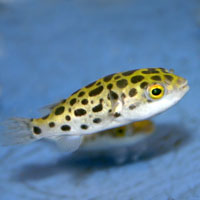
CLASSIFICATION:
Kingdom: Animalia
Phylum: Chordata
Class: Osteichthyes
Order: Tetraodontiformes
Family: Tetraodontidae (puffers), Diodontidae (porcupinefish)
Genus species: Many different kinds of puffer fish
SPECIAL
FEATURES:
The puffer fish has a unique
way of defense. It puffs up two times its size and also releases a
toxin called tetrodotoxin. This toxin makes a very unpleasant smell
and not a good meal for the predator. Tetrodotoxin is present in the
liver, blood, muscle tissue, ovaries, and intestine. If a human
should eat puffer fish meat they would be poisoned and taken to the
hospital.
REPRODUCTION:
The puffer fish has a unique reproduction
method. The females lay eggs at the shore after the males have pushed
them to a certain place. These are spherical in shape and usually
float on the surface because of their weight. The babies usually hatch
within a week. The larvae are covered in a shell that breaks within a
few days and the larvae develops fins, teeth, and all necessary parts.
|
|
GENERAL
INFO:
The Puffer fish is also known as the
blowfish, fugu, swellfish, and globefish. They are called puffer fish
because when it feel threatened it puffs up two times its actual size
by gulping water.

BODY
SYSTEMS:
Puffer fish have a small mouth, a tube-shaped
body and relatively small fins. When puffer fish puff up, they are
almost spherical. Puffer fish range in size from just a few inches
long to almost two feet long. Some species of puffer fish have spines
on their body, but many do not. The skin of puffers is very elastic
and can stretch well.

|
|
HABITAT:
There are around 100 different varieties of
puffer fish and they are found in coral reefs in the India, Pacific
and Atlantic Oceans. Many puffer fish can be found in fresh water as
well. Some puffer fish swim to freshwater and some live their entire
life in fresh water, without ever going to the sea. Most puffer fish
are found in sub-tropical and tropical marine waters along the coast
lines.

DIET:
Puffer fish are carnivores. They
eat corals, sponges, sea urchins and other echinoderms. Puffer fish
crush and grind up their prey with their heavy, fused teeth.
HUMAN
IMPACT:
The puffer fish has a powerful
toxin in its liver and ovary called tetrodotoxin. This toxin harms
humans when they eat puffer fish. The Japanese have a special way of
cooking and cutting the puffer fish so the toxins do not harm them
when eating puffer fish.
By:
Ashley and Katlyn
|



